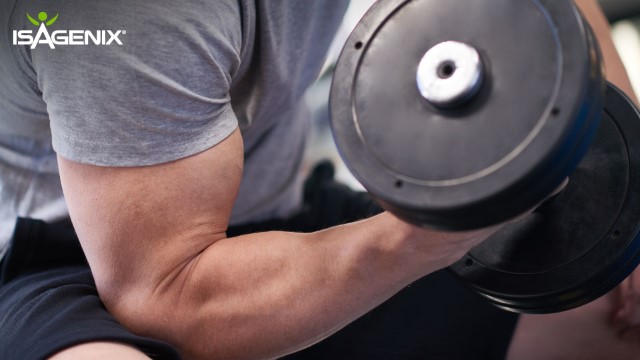The human body is capable of digesting large quantities of protein, but not all of it is used to synthesize muscle.
Following a meal, protein digestion starts in the stomach by pepsin in the presence of hydrochloric acid and continues in the small intestines. Pancreatic and intestinal enzymes work to break down protein into more manageable pieces for your body to use. The end products include peptide fragments and free amino acids that are absorbed almost exclusively in the small intestine.
The gut is a highly metabolically active organ, and extracts approximately 40 to 50 percent of the available amino acids from the ingested protein meal primarily for the purposes of energy production and local protein synthesis (1). The remaining amino acids are sent to the liver where, like in the gut, a portion is used for local metabolism. Rather than using the amino acids for fuel, the liver instead uses the majority to create blood proteins (2). From the liver, peptides and amino acids are then sent off in the plasma where they can be used by various tissues.
Although skeletal muscle is a large depot for amino acids, not all the amino acids released into plasma are incorporated into new muscle tissue. In a recent study tracing the path of protein throughout the body, investigators found that only about 2.2 grams or 11 percent of the amino acids provided to young men in a 20-gram serving of protein were used for protein synthesis (3).
Muscle protein synthesis activated by a protein meal reverts to baseline levels after two or three hours. Once stimulated, eating additional protein in this time frame does not further increase synthesis rates. This is termed the “muscle full” effect, meaning muscle cannot uptake additional amino acids (4).
Here’s the takeaway: to maximize muscle protein synthesis, protein meals should be separated by three to five hours over the waking period. The type of protein you consume also matters. Beyond factors such as illness, age, sex, and exercise, the type of protein can also affect how protein is partitioned in the body.
Lower-quality proteins, such as soy protein, which lack or are low in one or more essential amino acids, fail to stimulate muscle protein synthesis to the same degree as higher quality sources like whey. The constituent amino acids are less likely to be incorporated in muscle tissue at the same relative dose (5).
Assuming the consumption of high-quality proteins, a protein intake of beyond 0.3 grams per kg of body weight per meal is not going to provide muscle tissue with much more amino acids (6). For a 200-pound male, this is around 27 grams. While the additional protein may be used for other purposes, this level is the upper limit of what can be taken up by the muscle over several hours after eating.
For most people, this amount will fall between 20 and 30 grams of high-quality protein per meal (7). However, protein requirements have been reported to be greater for older individuals who may become less sensitive to the muscle synthesis effects of protein (8). Numerous studies have demonstrated that ingestion of 35 to 40 grams of protein stimulates greater rates of muscle protein synthesis than lower doses of protein for this group (9-12).
References
- Nakshabendi IM, McKee R, Downie S et al. Rates of small intestinal mucosal protein synthesis in human jejunum and ileum. Am J Physiol. 1999 Dec;277(6 Pt 1): E1028-31.
- Cayol M, Boirie Y, Prugnaud J et al. Precursor pool for hepatic protein synthesis in humans: effects of tracer route infusion and dietary proteins. Am J Physiol. 1996 Jun;270(6 Pt 1): E980-7.
- Groen BB, Horstman AM, Hamer HM et al. Post-Prandial Protein Handling: You Are What You Just Ate. PLoS One. 2015 Nov 10;10(11): e0141582.
- Bohé J, Low JF, Wolfe RR et al. Latency and duration of stimulation of human muscle protein synthesis during continuous infusion of amino acids. J Physiol. 2001 Apr 15;532(Pt 2):575-9.
- Tang JE, Moore DR, Kujbida GW et al. Ingestion of whey hydrolysate, casein, or soy protein isolate: effects on mixed muscle protein synthesis at rest and following resistance exercise in young men. J Appl Physiol (1985). 2009 Sep;107(3):987-92.
- Stokes T, Hector AJ, Morton RW et al. Recent Perspectives Regarding the Role of Dietary Protein for the Promotion of Muscle Hypertrophy with Resistance Exercise Training. Nutrients. 2018 Feb 7;10(2).
- Jager R, Kerksick CM, Campbell BI et al. International Society of Sports Nutrition Position Stand: protein and exercise. J Int Soc Sports Nutr. 2017 Jun 20; 14:20.
- Churchward-Venne TA, Breen L, Phillips SM. Alterations in human muscle protein metabolism with aging: Protein and exercise as countermeasures to offset sarcopenia. Biofactors. 2014 Mar-Apr;40(2):199-205.
- Pennings B, Groen B, de Lange A et al. Amino acid absorption and subsequent muscle protein accretion following graded intakes of whey protein in elderly men. Am J Physiol Endocrinol Metab. 2012 Apr 15;302(8): E992-9.
- Yang Y, Breen L, Burd NA et al. Resistance exercise enhances myofibrillar protein synthesis with graded intakes of whey protein in older men. Br J Nutr. 2012 Nov 28;108(10):1780-8.
- Yang Y, Churchward-Venne TA, Burd NA et al. Myofibrillar protein synthesis following ingestion of soy protein isolate at rest and after resistance exercise in elderly men. Nutr Metab. 2012 Jun 14;9(1):57.
- Robinson MJ, Burd NA, Breen L et al. Dose-dependent responses of myofibrillar protein synthesis with beef ingestion are enhanced with resistance exercise in middle-aged men. Appl Physiol Nutr Metab. 2013 Feb;38(2):120-5.





